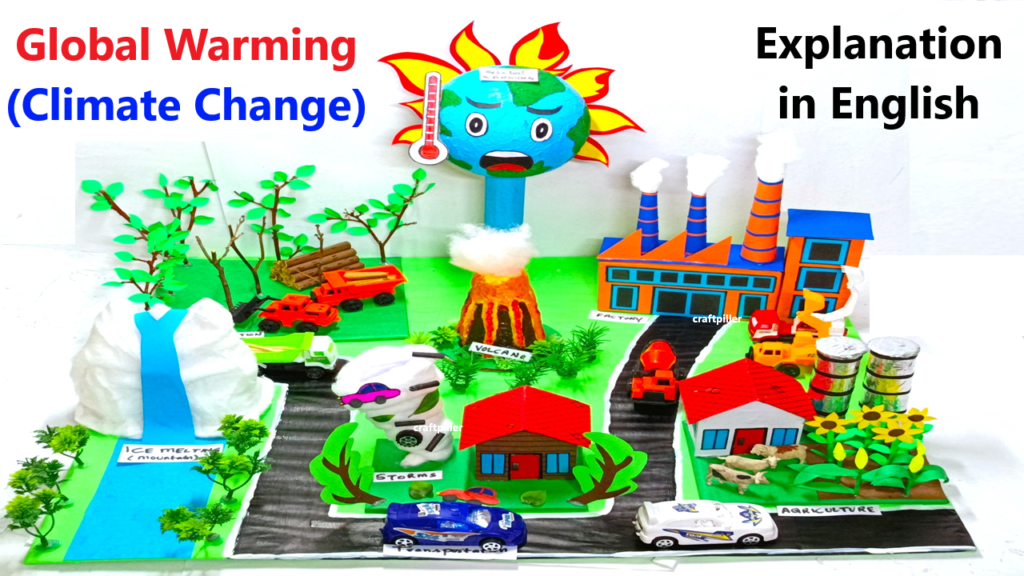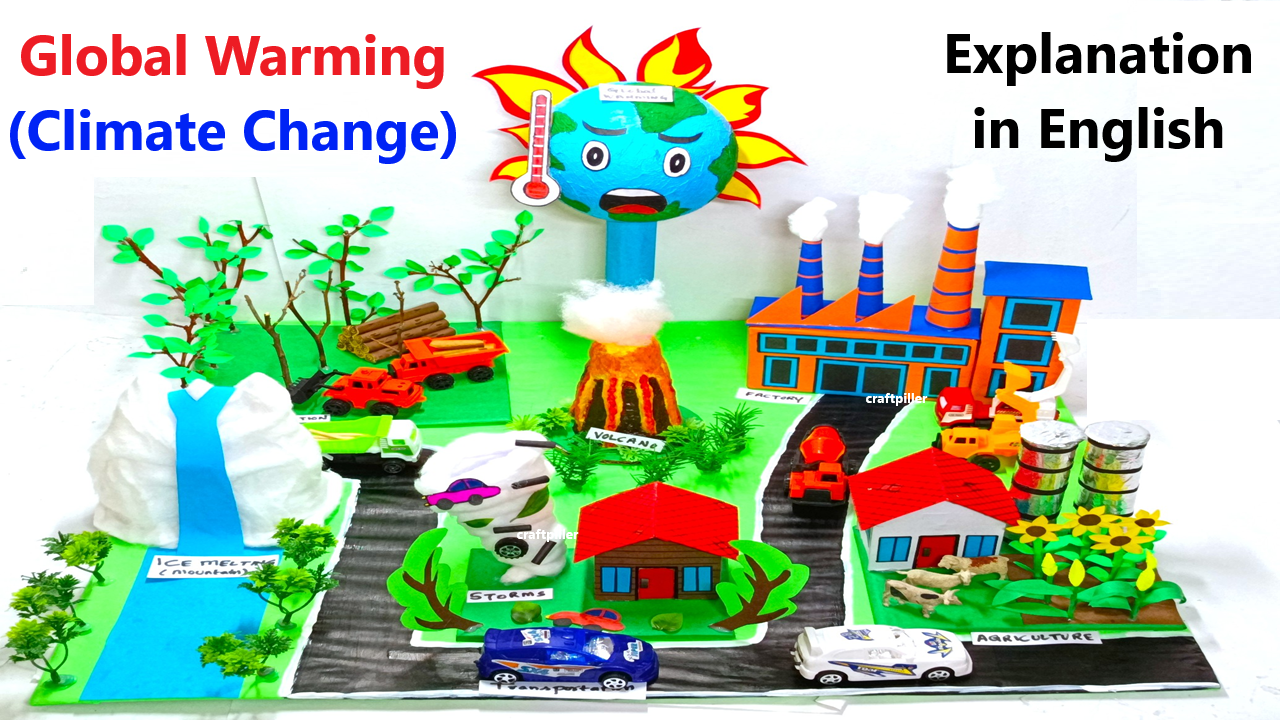Objective:
To create a DIY working model that demonstrates global warming, the greenhouse effect, and the impact of human activities on climate change, using visual elements like a ball for Earth, a factory, forest, ice melt, thunderstorm, and bad agricultural practices.

Materials Required:
- Cardboard (for the base and supporting structures)
- Color paper (for decorations, labels, and environmental elements)
- Styrofoam or small ball (to represent the Earth)
- Plastic or cardboard (to build the factory, farm, and forest)
- Cotton or white paper (to represent clouds and thunderstorm effects)
- Blue paint (to color the Earth)
- LED lights (optional, to represent sunlight)
- Markers, pens, and labels (for explanations and descriptions)
- Glue, scissors, and tape (for assembling)
- Plastic wrap or clear plastic sheet (to represent the greenhouse effect)
Steps to Build the Model Global Warming & Greenhouse Effect Working Model:
Prepare the Base:
- Cut a large piece of cardboard to create the foundation of your model.
- Paint the cardboard in a light color or use color paper to make it more visually appealing.
- Create the Earth:
- Paint the Styrofoam ball blue and green to represent the Earth.
- Place the ball at the center of the cardboard to serve as the focal point.
- Build the Factory:
- Construct a small factory from cardboard, using black or gray paper to give it a factory-like appearance. Add “smoke” using cotton to show pollution being released into the atmosphere.
- Place the factory on one side of the Earth to show the industrial impact on the environment.
- Create the Forest:
- Cut trees from green color paper or cardboard to represent forests. Glue them around the Earth to symbolize the importance of forests in carbon absorption.
- You can create a contrasting scene by showing deforestation or cutting down trees in another section of the model, demonstrating the impact of poor agricultural practices.
- Simulate Ice Melt:
- Use small pieces of white cotton or foam to represent ice. Place these around the Earth, particularly near the poles.
- You can show melting ice by creating a “melted” section with water-colored paper or plastic wrap to represent rising sea levels and melting glaciers due to global warming.
- Create the Thunderstorm:
- Use cotton or white paper to create clouds or thunderstorms. Attach them above the Earth model.
- You can add small LED lights to represent lightning or the intensified weather patterns due to climate change.
- Bad Agricultural Practices:
- Cut pieces of brown or yellow color paper to represent bad agricultural practices like over-farming or deforestation.
- Place them on a section of the Earth or farm to show how human activity is contributing to soil degradation, greenhouse gas emissions, and loss of biodiversity.
- Greenhouse Effect Simulation:
- Use a clear plastic sheet or plastic wrap to create a “greenhouse” around the Earth. This will simulate the greenhouse effect, trapping heat and warming the Earth.
- Label this section of the model and explain how human activities, like burning fossil fuels, increase greenhouse gases in the atmosphere, causing the Earth’s temperature to rise.
- Add LED Lights for the Sun:
- If you choose, you can place small LED lights near the Earth to represent sunlight. The lights can shine on the plastic sheet or wrap, simulating the effect of sunlight being trapped by greenhouse gases.
- Label the Impact of Each Element:
- Use labels or short descriptions near each element (factory, forest, ice melt, etc.) to explain how it contributes to global warming and climate change.
- Example labels:
- Factory: “Releases CO2 and other greenhouse gases into the atmosphere.”
- Forest: “Absorbs CO2 and helps mitigate climate change.”
- Bad Agriculture: “Leads to soil erosion, loss of biodiversity, and increased CO2 emissions.”
- Greenhouse Effect: “Traps heat in the atmosphere, causing global warming.”
- Ice Melt: “Melting ice contributes to rising sea levels.”
- Thunderstorm: “Intensified by global warming, leading to more extreme weather patterns.”
How It Works:
- The model should visually show how different elements (factories, forests, bad agricultural practices) affect global warming.
- When the factory emits pollution, it will be trapped by the greenhouse effect, causing the Earth to warm and leading to melting ice.
- The model will also show the consequences of deforestation and poor agricultural practices.
- Thunderstorms and extreme weather will become more frequent due to the changing climate, creating a cyclical and self-reinforcing process.

